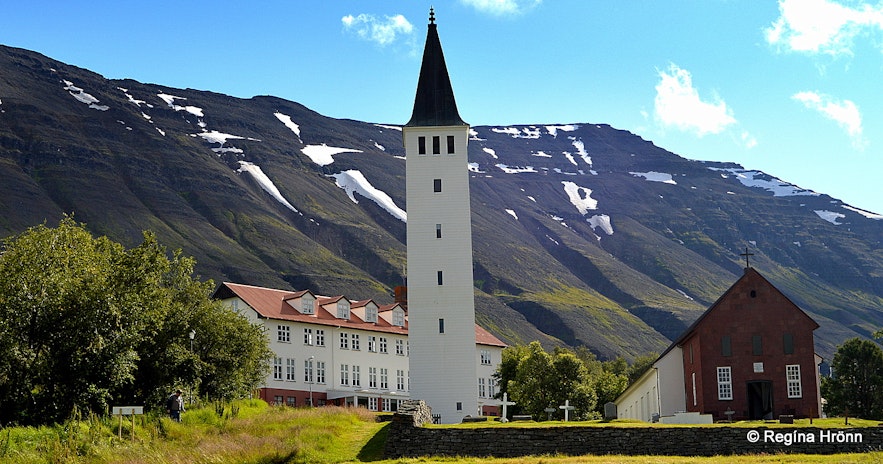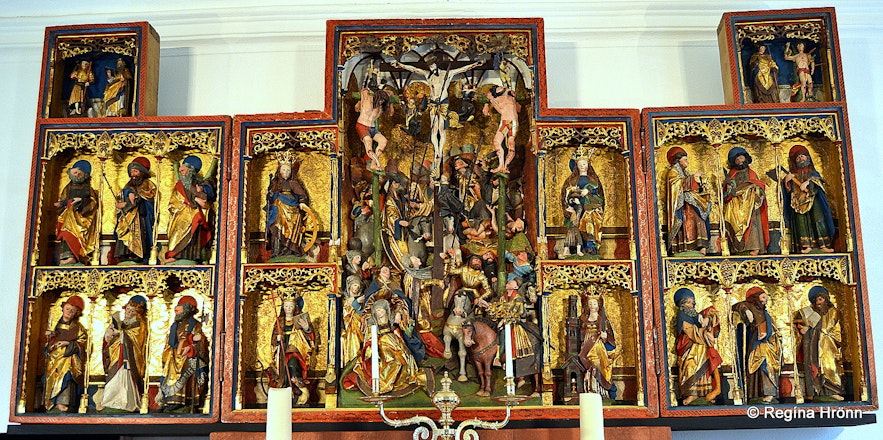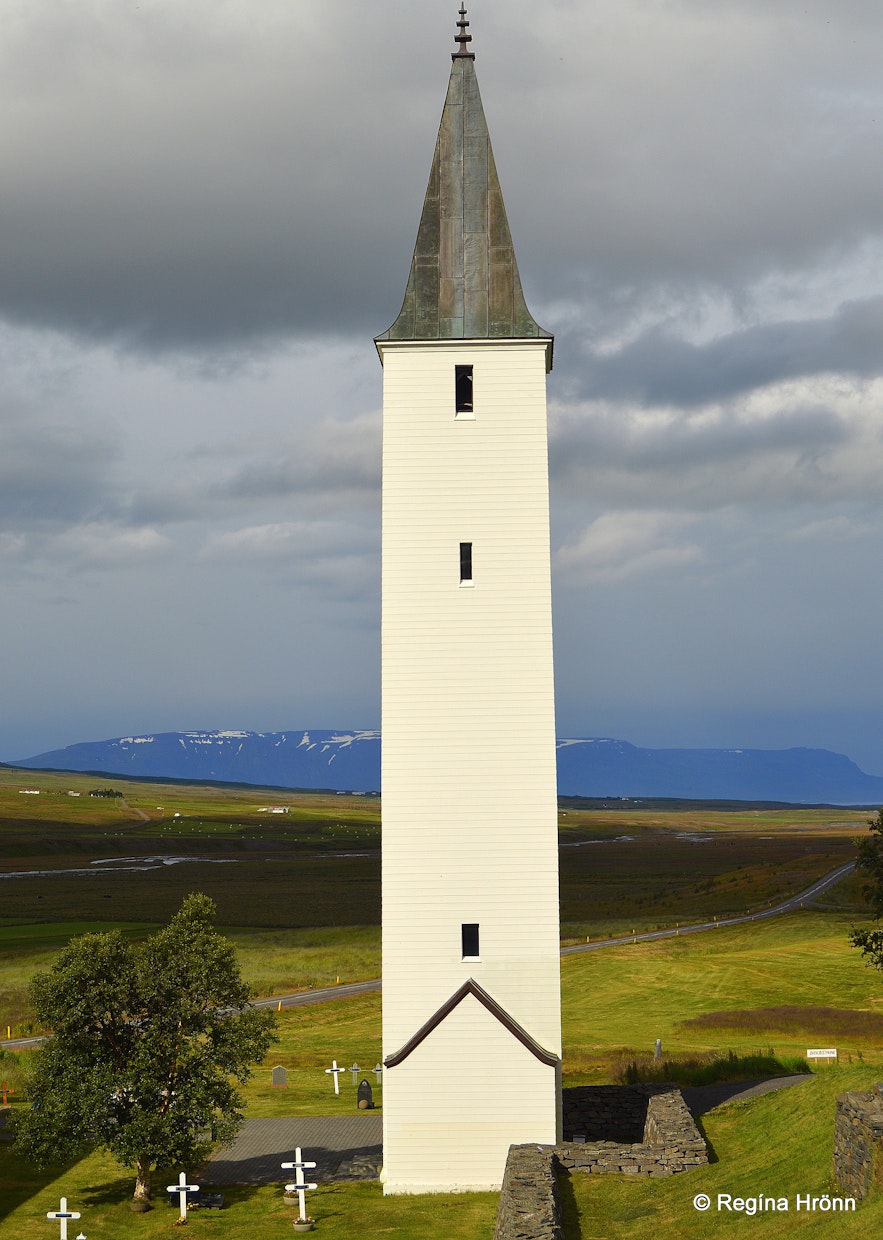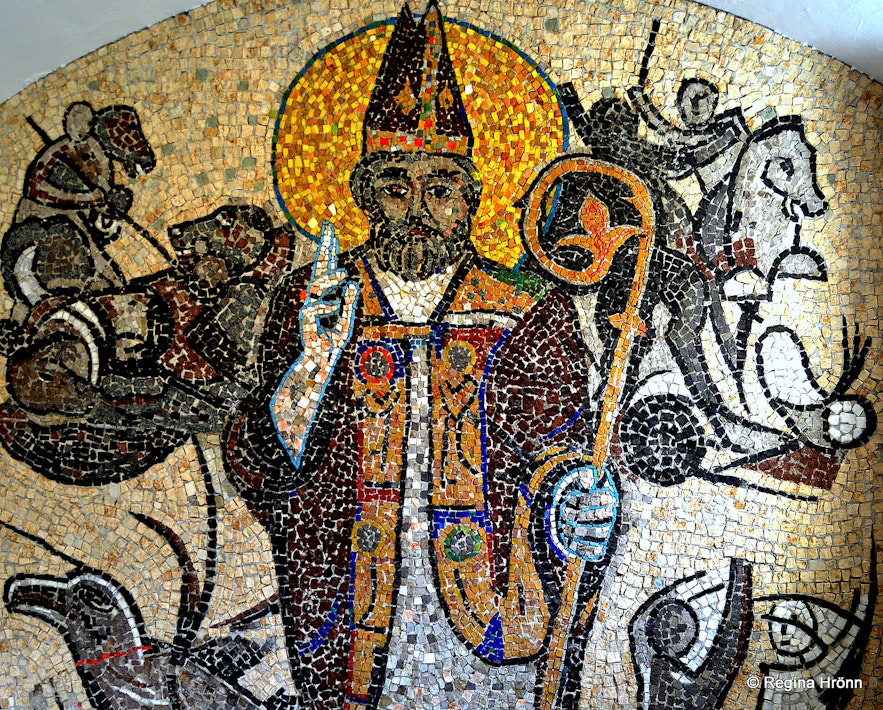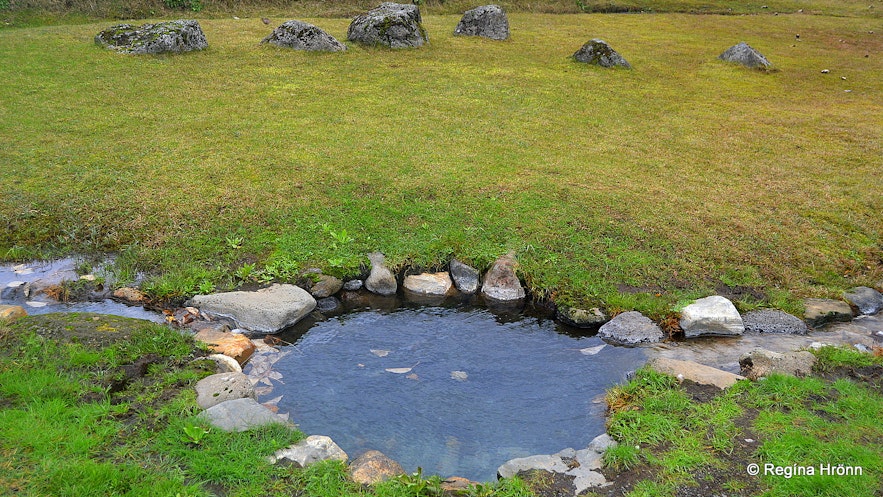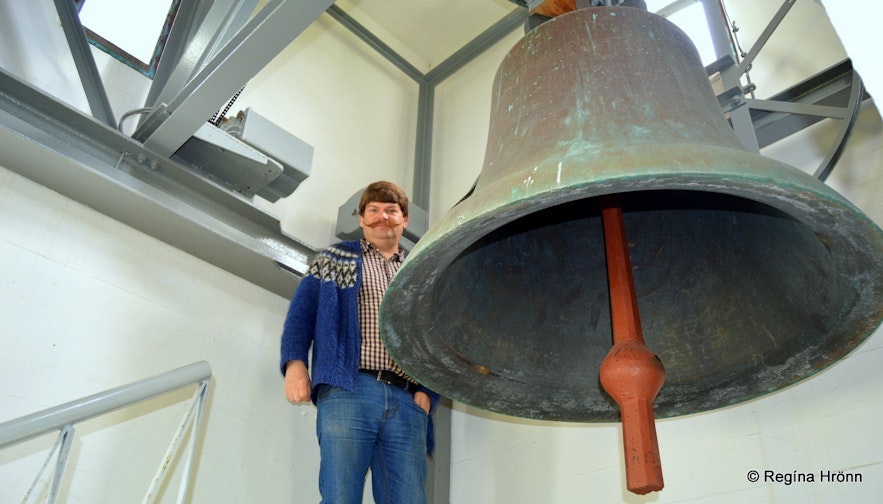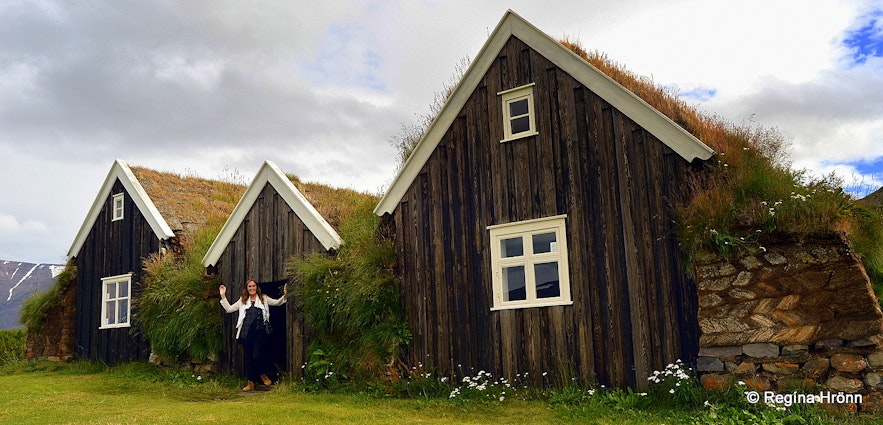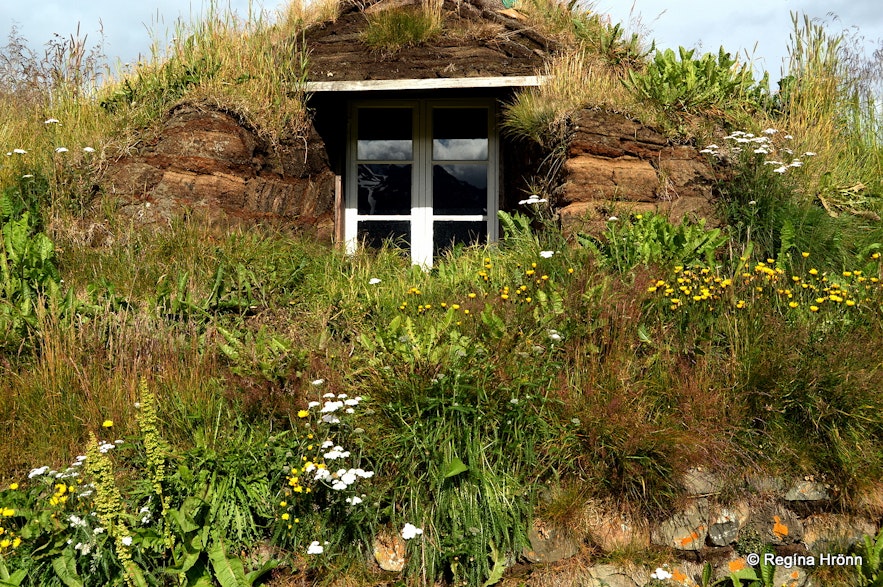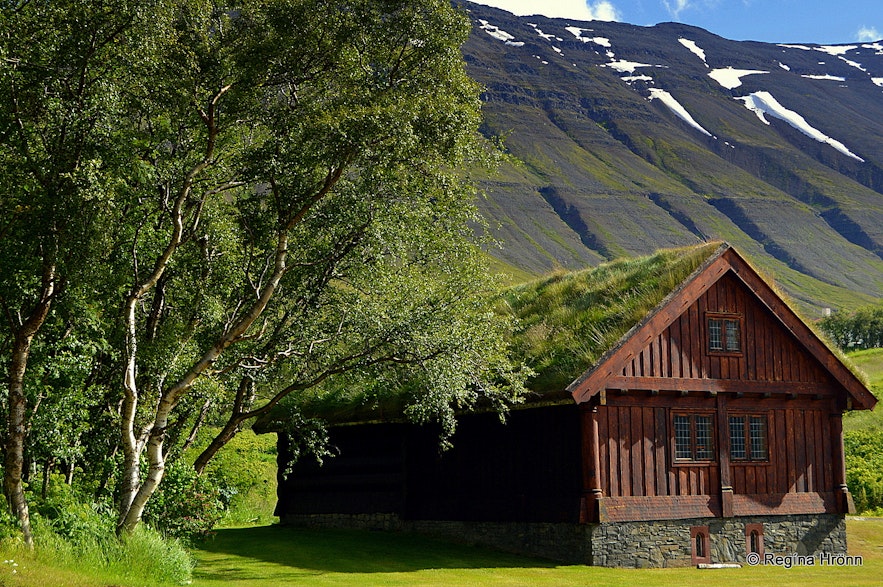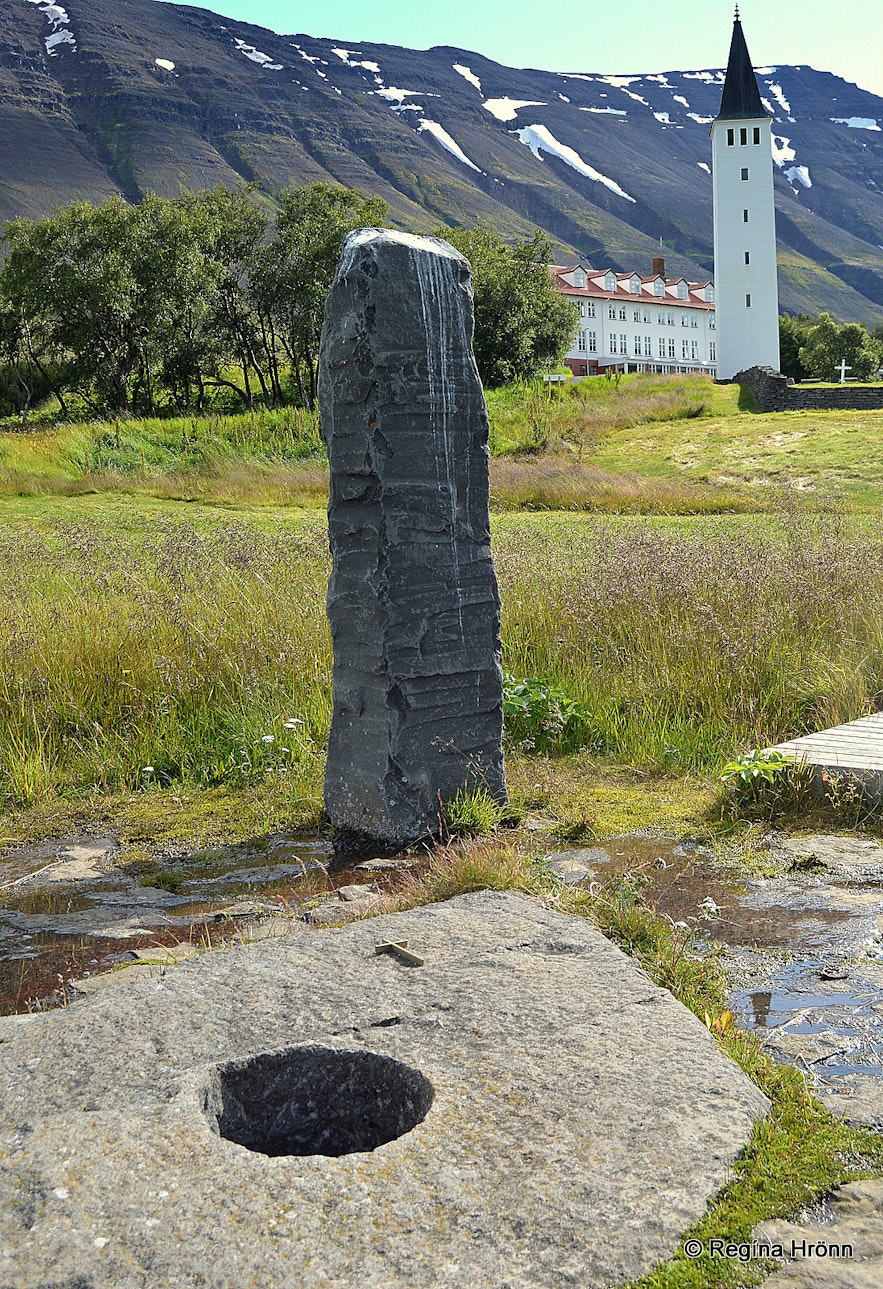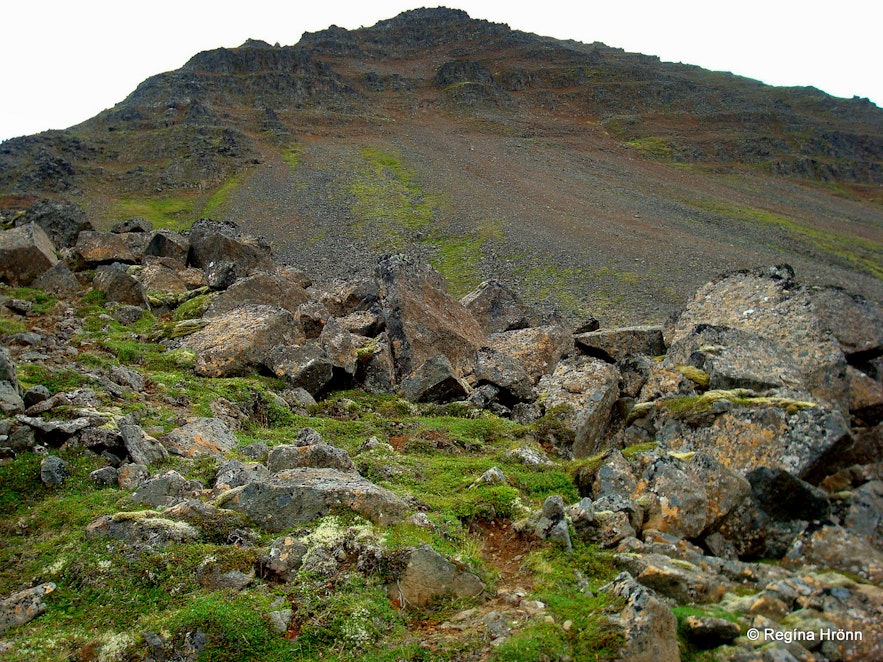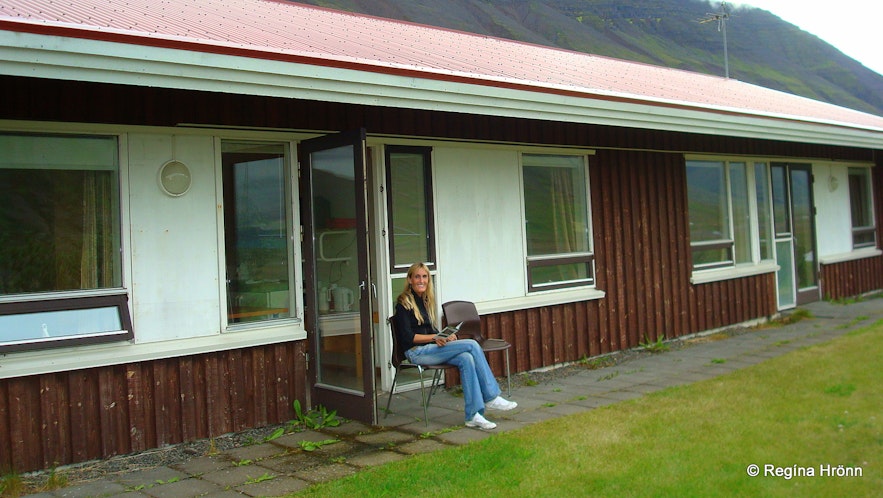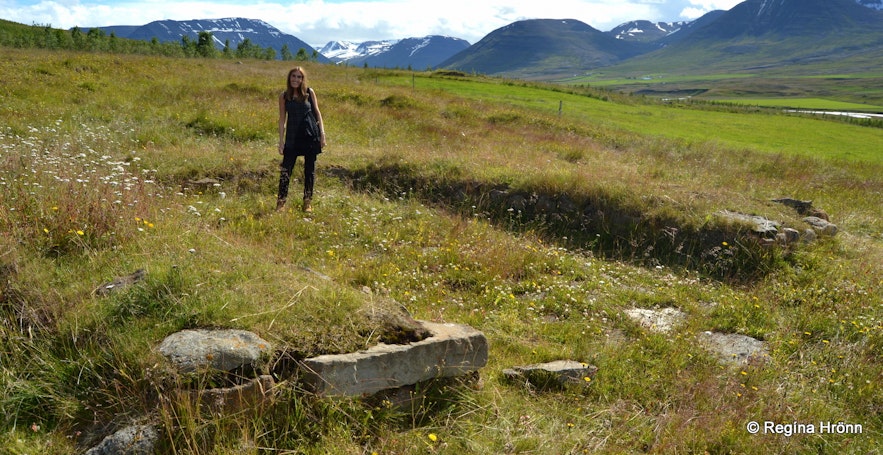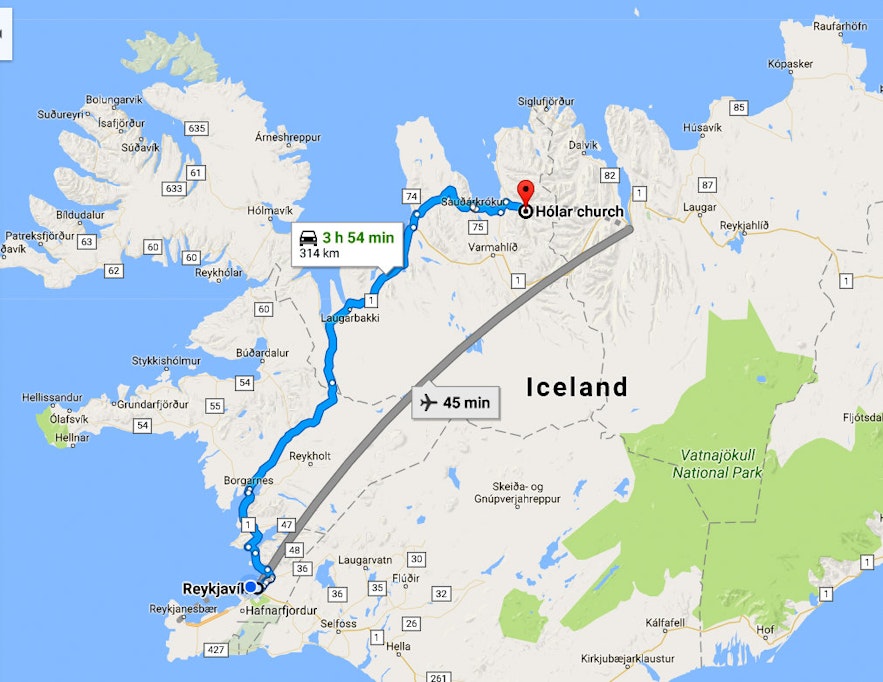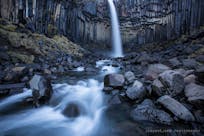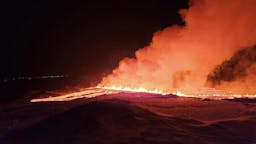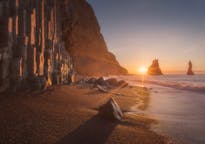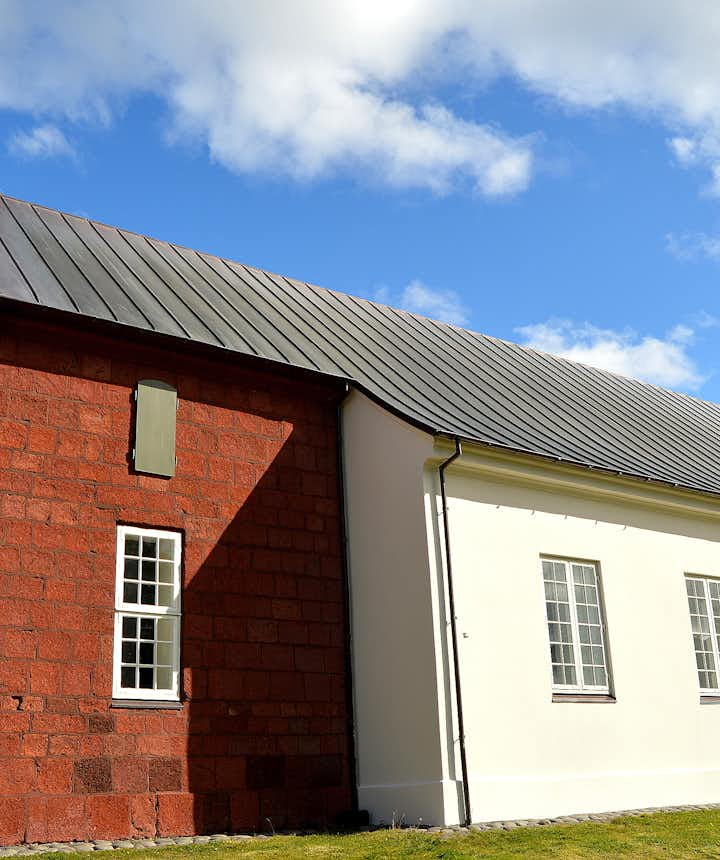
The historic Hólar in Hjaltadalur, the Episcopal See and Nýibær Turf House in North-Iceland
In this travel-blog I am going to show you Hólar in Hjaltadalur, which is one of my favourite places in Iceland.
Hólar is such a special place in Iceland and one of the best-known historic sites here. It is very dear to us Icelanders.
 A sign in Hjaltadalur leading to Hólar
A sign in Hjaltadalur leading to Hólar
To me, it is one of the most special places in Iceland and I always stay here when travelling in this area. It always warms my heart when I see Hólar appearing when driving in Hjaltadalur valley.
My first photo was taken on an August night when Hólar was bathed in the midnight sun.
Hólar in Hjaltadalur
For some 700 years, Hólar was the capital of the north until Akureyri got that title. From 1106-1801 Hólar was one of 2 bishoprics in Iceland - the Northern bishopric and the educational capital of the north.
All in all, there were 36 bishops at Hólar, 23 Catholic, and 13 Lutheran.
The Agricultural school at Hólar has been operating since 1882. And there has been a University College at Hólar since 2003.
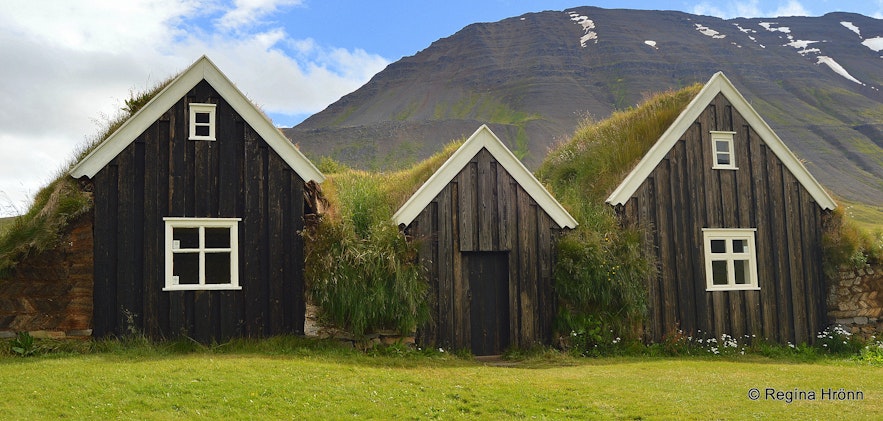 Nýibær turf house
Nýibær turf house
Among the buildings, you can see at Hólar is Hólakirkja Cathedral from 1763, Nýibær turf house from 1854, and Auðunarstofa log house.
If you want to read an excellent poem about Hólar in Icelandic, then Matthías Jochumsson wrote about Skagafjörður and Hólar in his poem Skín við sólu Skagafjörður in 1890.
Hólakirkja Cathedral
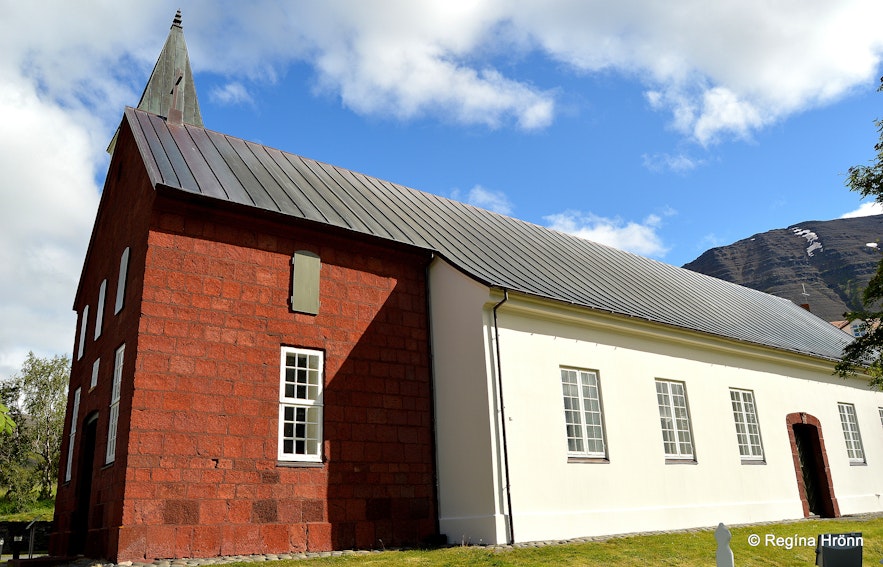
Hólakirkja cathedral
A church has been at Hólar since the 11th century. The current church was consecrated in 1763 and is the oldest stone church in Iceland.
It is the oldest remaining church in Iceland apart from the oldest parts (from the 17th century) of the beautiful Grafarkirkja turf church, which is 22 km away from Hólar.
It is red and white in colour, built from stones from the mountain Hólabyrða above Hólar. Some of the stones in the church might be from an older unfinished church that was erected by Bishop Auðunn rauði Þorbergsson in the 14th century.
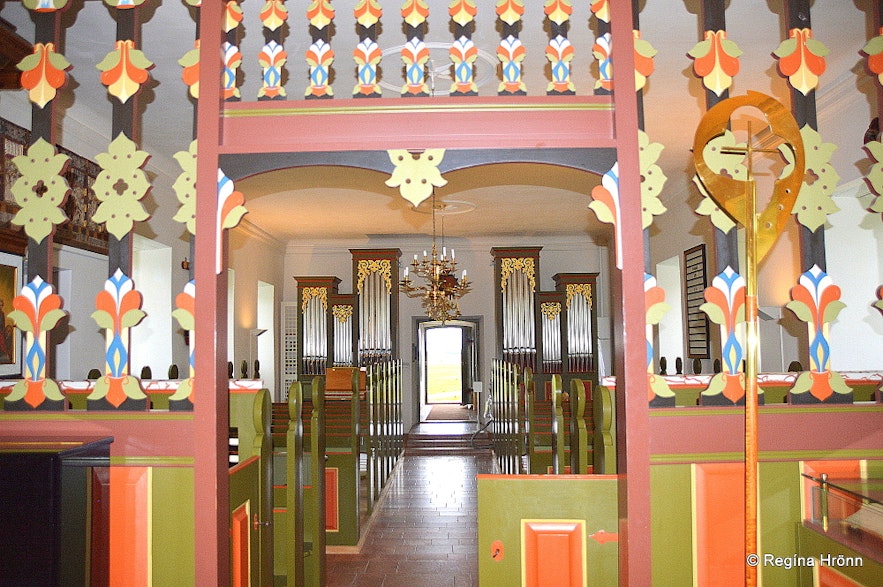 Inside Hóladómkirkja cathedral
Inside Hóladómkirkja cathedral
Hólakirkja cathedral is the seventh church on this site and the fifth cathedral.
The first bishop at Hólar was Jón Ögmundsson (from 1106-1121).
Other well-known bishops are Guðmundur góði Arason (1203-1237), Guðbrandur Þorláksson, who published the first Icelandic Bible, Guðbrandsbiblía Bible, in 1584, and Jón Arason (1524-1550), who was the last Catholic bishop at Hólar.
The altarpiece which Bishop Jón Arason donated to the cathedral
Bishop Jón Arason, who was beheaded at Skálholt during the Reformation, donated some treasures to the Hóladómkirkja cathedral in the first parts of the 16th century, including the beautiful altarpiece, which we call Hólabríkin in Icelandic.
It is believed that Bishop Jón bought this altarpiece in 1520-1525 in Holland.
This masterpiece is made of wood, covered with plaster, painted, and plated with gold.
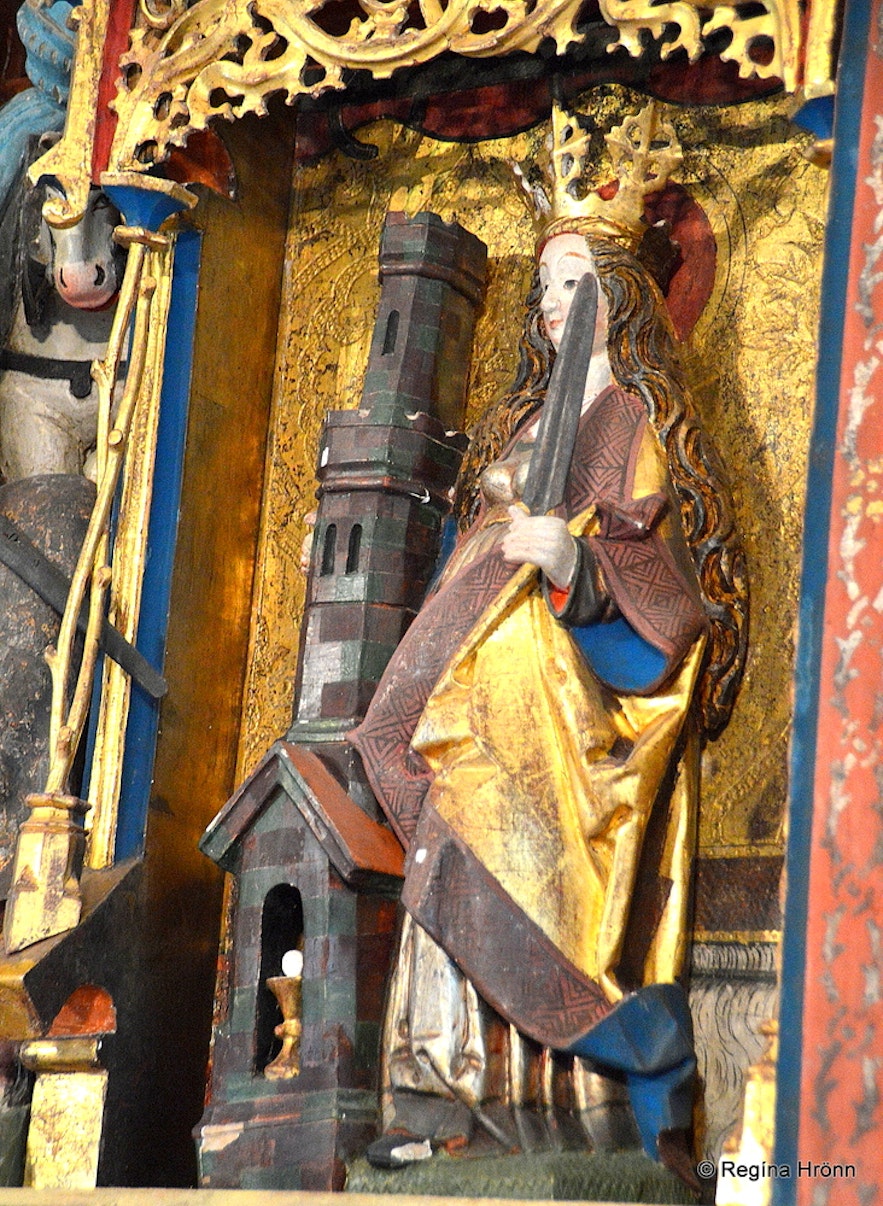 St. Barbara with the tower is a part of the altarpiece
St. Barbara with the tower is a part of the altarpiece
There are beautiful details in the altarpiece and I photographed every detail to have a look at them at home.
On the altarpiece, you can see the apostles and saints, and martyrs, some of which are not well-known to us Icelanders today since the Reformation took place in 1550.
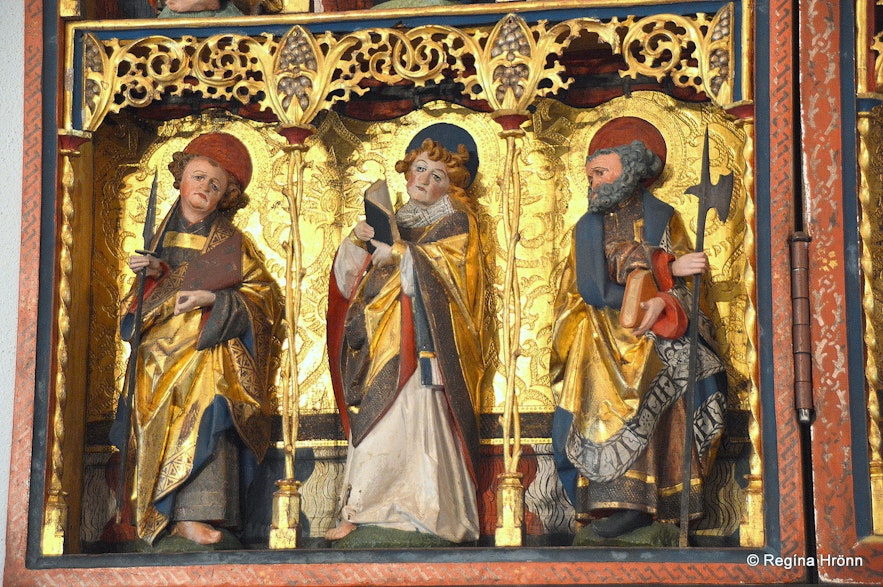 The Apostles Thomas, Mattheus, and Philip
The Apostles Thomas, Mattheus, and Philip
The altarpiece is very heavy and the story goes that the Danish wanted to remove it from the cathedral following the execution of bishop Jón Arason in 1550, but had to leave it as it was way too heavy and the horses couldn't carry it.
You will find another smaller altarpiece hanging over the door of the cathedral. We call it alabastursbríkin.
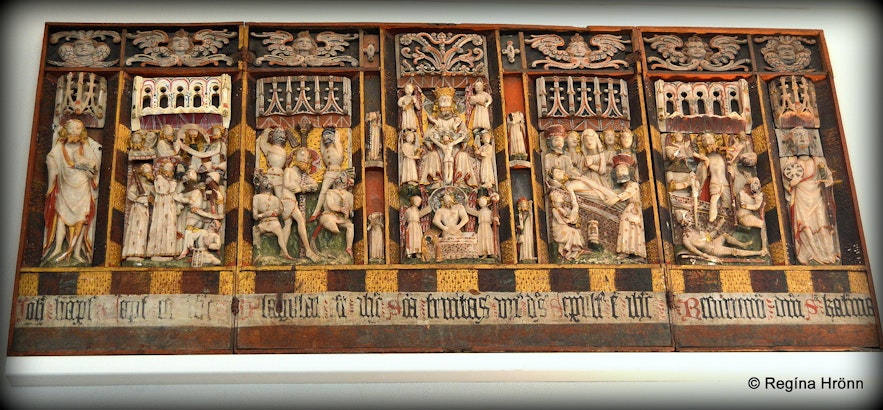 The old alabaster altarpiece
The old alabaster altarpiece
The altarpiece is made of alabaster, and most likely dates back to 1470, made in Nottingham in England.
There were several alabaster altarpieces in Icelandic churches, many of which were destroyed after the Reformation, so we are glad that this one survived.
This altarpiece was moved to the National Museum of Iceland back in 1899, fixed, and has been on loan from the museum since 1988.
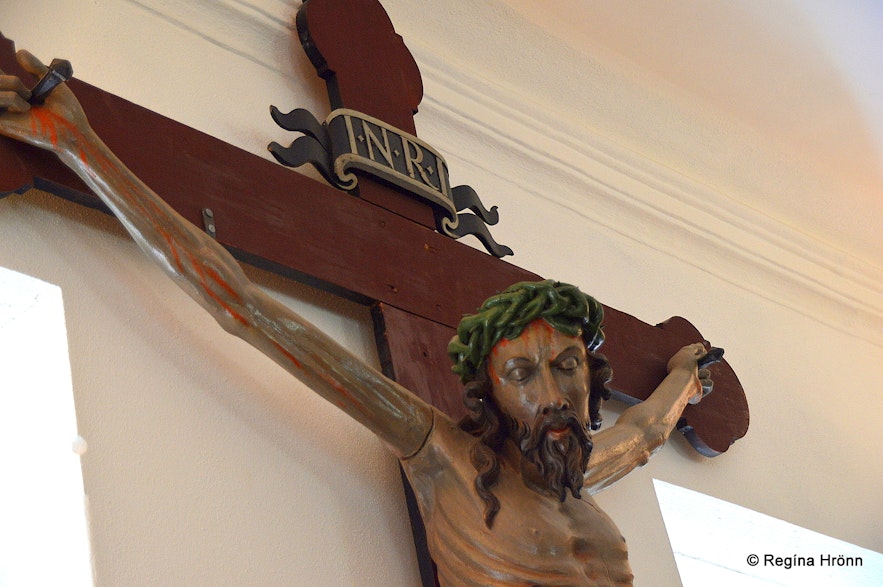 The old Holy Rood (róðukross)
The old Holy Rood (róðukross)
Other old objects in the Hóladómkirkja church is the man-size Holy Rood, which dates back to the early part of the 16th century or even earlier. It is a foreign crucifix.
And a steatite stone baptismal font which was carved by Guðmundur Guðmundsson from Bjarnastaðahlíð in 1674, but the year is carved into the baptismal font.
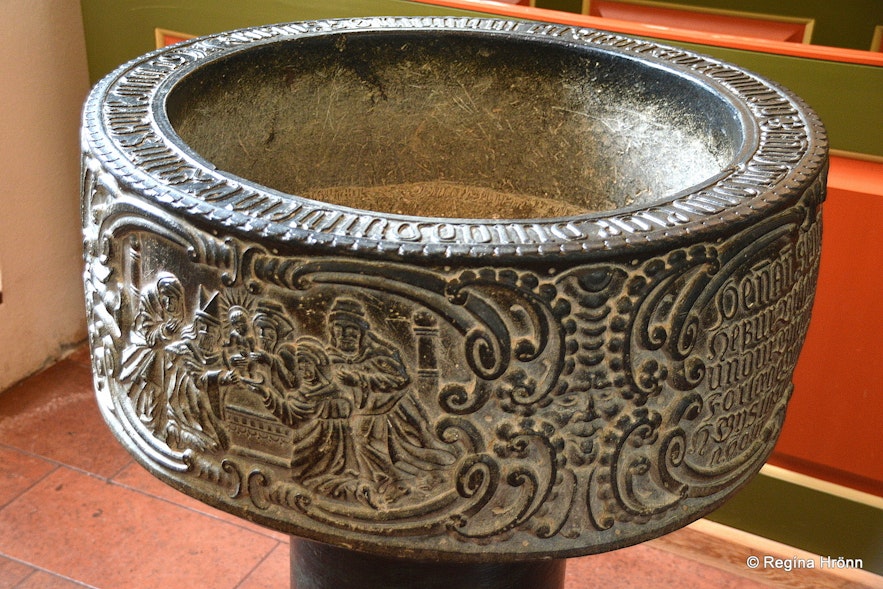 The beautiful baptismal font in Hólakirkja cathedral
The beautiful baptismal font in Hólakirkja cathedral
Steatite isn't available in Iceland, so it was either imported or drifted on an iceberg from Greenland, we don't know for sure.
There are speculations that one of the Norwegian bishops at Hólar imported the baptismal font from Norway and that Guðmundur Guðmundsson carved it much later when he came back from his 10-year studies in Germany.
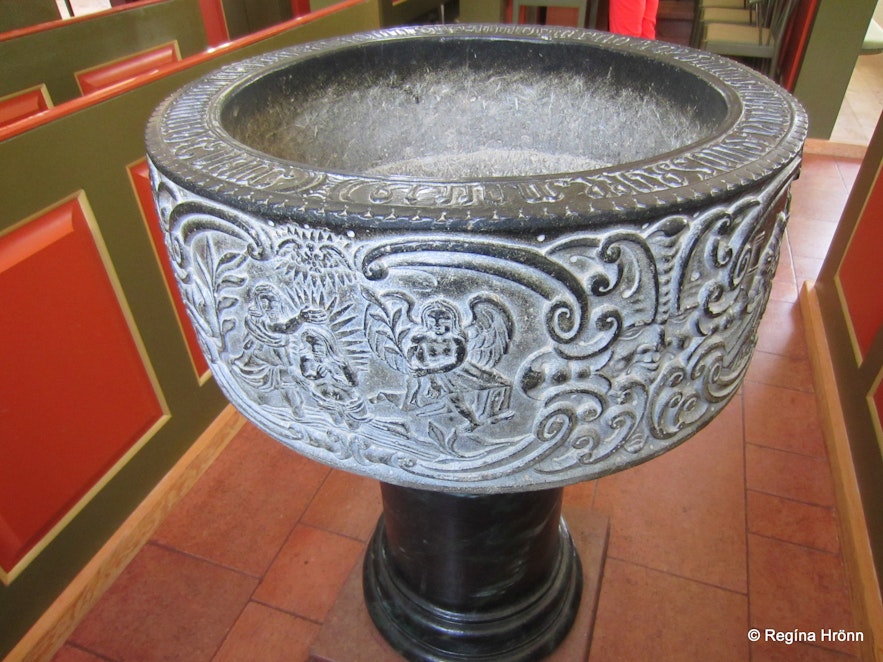 Is this the oldest artifact in Hólakirkja cathedral?
Is this the oldest artifact in Hólakirkja cathedral?
There still exist some very similar baptismal fonts in Norway from the 12th-14th centuries, but they aren't decorated like this one. So this baptismal font might be the oldest treasure in the cathedral.
There are many beautiful things to see in the cathedral, f.ex. the pulpit.
The pulpit in Hólakirkja cathedral is made of oak and beautifully painted on it are the 4 Evangelists.
It was sent from Copenhagen to Iceland in 1762.
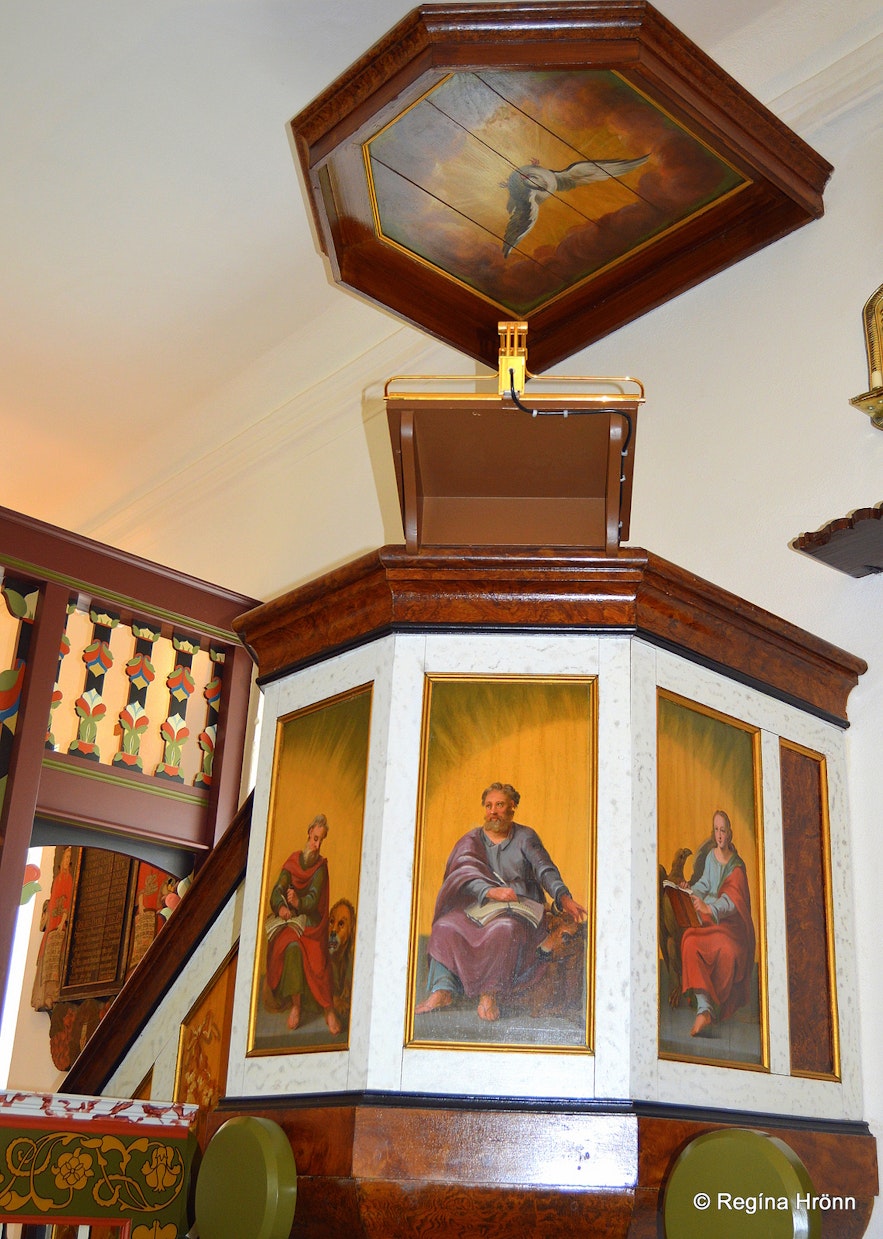
The pulpit in Hólakirkja cathedral
Bishop Jón Arason donated an exquisite choir cape to Hóladómkirkja cathedral in 1540. It now belongs to the National Museum of Iceland.
The choir cape is believed to have been made in Arras in France in the first part of the 16th century.
The choir cope is one of the greatest treasures of the National Museum of Iceland as it is the only choir cope left from catholic times in Iceland.
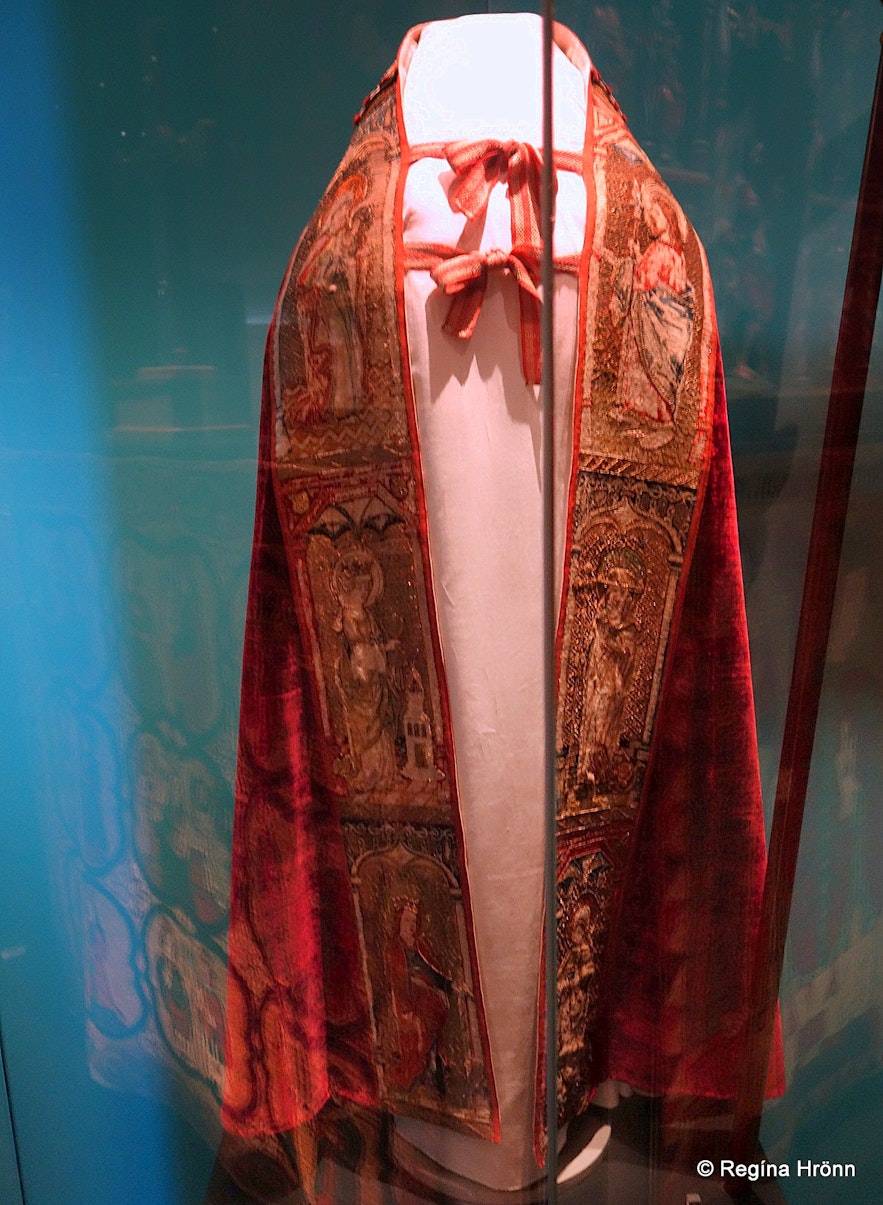 The choir cape of bishop Jón Arason
The choir cape of bishop Jón Arason
A replica of the choir cope of Jón Arason was made when Ólína Bragadóttir Weightman sewed an exquisite choir cape for Hólar.
Jón Aðalsteinn Baldvinsson, the former ordination bishop at Hólar (2003-2011), and his wife Margrét Sigtryggsdóttir donated the choir cope to Hólar in remembrance of their daughter Sigríður Jónsdóttir. It took Ólína 3 years, 4 hours a day, 5 days a week, to finish this beautiful choir cope.
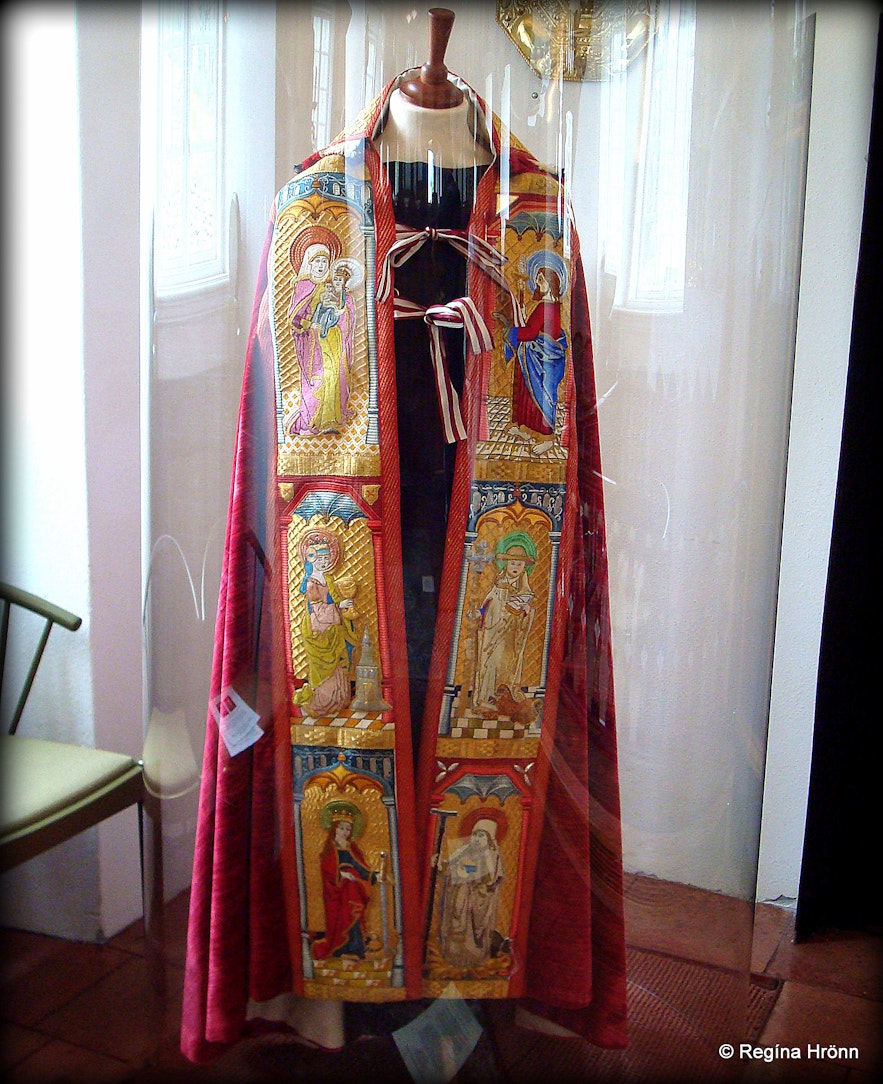 The new choir cape at Hólar
The new choir cape at Hólar
Jón Aðalsteinn was the first one to consecrate the new choir cope at Hólahátíð back in 2008.
The latest ordination bishop at Hólar, Gísli Gunnarsson, was ordained on the 14th of August 2022 and the choir cope changed hands.
The Church tower
The 27 m high church tower
The church tower is so magnificent and one of a kind here in Iceland. It is freestanding and 27 meters high and stands next to the church.
The tower was built in 1950 on the 400th anniversary of the death of bishop Jón Arason, who was the last Catholic bishop of Iceland and is a monument for Jón and his sons, Björn and Ari.
The mosaic of Jón at Hólar inside the church tower
The church tower is open to visitors and it is possible to walk up to the church bell.
On the ground floor of the church tower, you will find a tiny chapel with beautiful mosaics of Jón and a church bell. Here is the grave of Bishop Jón Arason.
The mosaic was made by the well-known artist Erró, back in 1957, when he was still called Ferró.
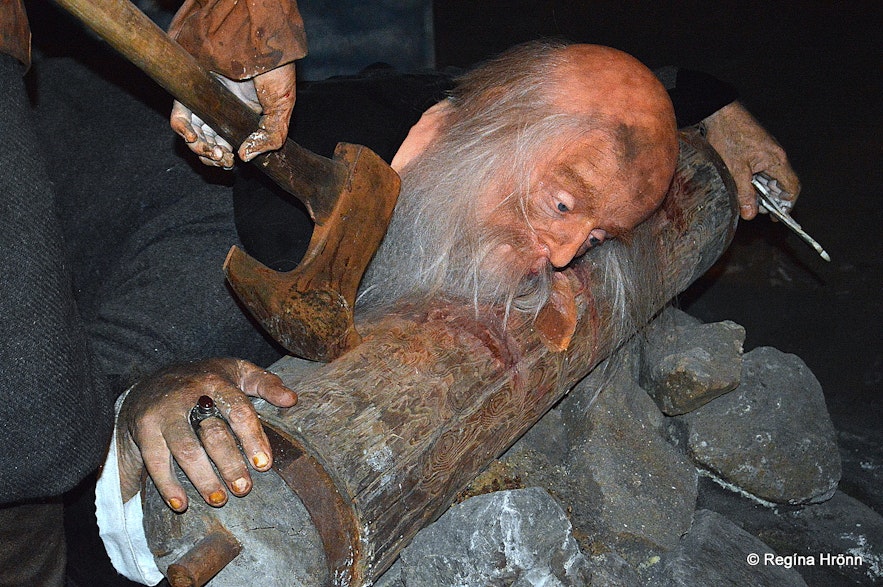
The beheading of Jón Arason as depicted at the Saga Museum in Reykjavík, which I recommend visiting
Jón was beheaded on the 7th of November 1550 at Skálholt together with his sons, Björn and Ari, during the Reformation - the change from Catholicism to Lutheranism. A very tragic story.
The Vikings had converted to Christianity back in the year 1000 at Þingvellir, but the Reformation in 1550 took a bloody turn.
Jón and his sons were buried at Skálholt, but the spring after the execution the men from the northern part of Iceland rode to Skálholt, exhumed the bodies, and took them with them to Hólar for a proper burial.
Vígðalaug at Laugarvatn
The bodies were covered in mud and on their way up north, they washed the bodies in the holy spring, Vígðalaug - Holy Spring - at Laugarvatn in South Iceland.
The rocks above the holy spring are called Líkasteinar, but it is believed that the biers for the bodies were laid on these 6 stones while the bodies were being washed.
Here in Vígðalaug the Vikings from the north and south were baptized after the conversion in the year 1000 at Þingvellir.

Beautiful mosaic at Hólar
I found old folklore on this event in Þjóðsögur Jóns Árnasonar - the Collection of Folklore by Jón Árnason:
"It is said that in Hólakirkja church in Hjaltadalur valley, the bell Líkaböng still hangs.
The story goes according to an account from up north that the bell had started ringing on its own when the bodies of Jón Arason and his sons were transported north from Skálholt.
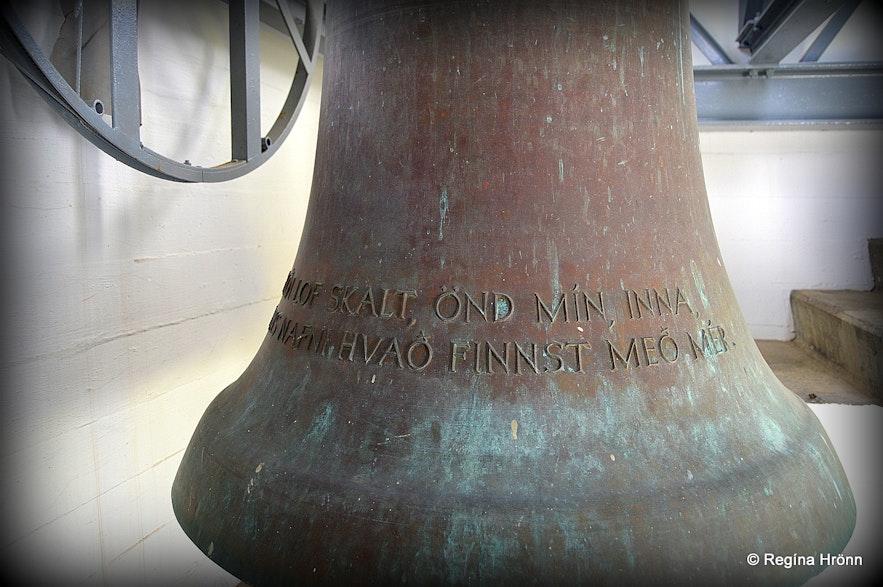
The bell in the church tower
The story goes that the bell started ringing when the cortege arrived at Vatnsskarð, from where you can see Skagafjörður, and then it stopped; the second time the bell rang when the cortege arrived at Hrísháls, from where you can first see Hólar in the Hjaltadalur valley, and the third time when the bodies were carried into Hólar.
It carried on ringing with such great force when the bodies were carried into the church that it cracked. This incident is believed to be a symbol and a testimony of how badly even mortal things in North Iceland reacted to the execution of Bishop Jón."
(Translated into English from Þjóðsögur Jóns Árnasonar - RHR)
This is my Jón and the bell in the church tower at Hólar
I always visit the Cathedral in awe as there is such a big part of Iceland's history here.
There are so many artifacts in the Cathedral and a very ornate altarpiece - we Icelanders are not used to such ornamental churches, being Lutheran.
Nýibær turf-house at Hólar in Hjaltadalur
Nýibær turf-house
At Hólar there is a lovely turf-house called Nýibær - New Farm, built in 1860. It is called Nýibær - New farm as the old farm was still standing when the new farm was built.
Rev. Benedikt Vigfússon built this turf farm for himself and left the old farm to his son.
People lived in the turf-house until 1945.
Nýibær turf-farm is now in the index of archaeological sites and relics and has belonged to the National Museum of Iceland since 1956, and opened to the public in 1958. It is open and admission is free.

The old hearth kitchen in Nýibær turf-house
But it is different from other turf-houses, which are now museums in Iceland, in that it is almost empty, and the turf-house itself is the showpiece.
And it is a beautiful showpiece, both inside and out.
It is especially interesting walking around it, seeing the small windows in what seems to be only a grass mound.
Nýibær turf-house
The turf farms only look like houses from the front - they are totally different from the side and from the back.
I love turf houses and have written another travel blog about the majority of turf houses in Iceland:
A list of the beautiful Icelandic Turf Houses, which I have visited on my travels in Iceland.
Auðunarstofa log-house
Auðunarstofa log-house
You will see a beautiful log house at Hólar. It was erected in remembrance of the Norwegian Auðun rauði Þorbergsson, who was a bishop at Hólar from 1313-1322.
While he was a bishop he built a log house from Norwegian wood which he carried to Iceland with him from Norway. It became the quarters of the bishops at Hólar for five centuries.
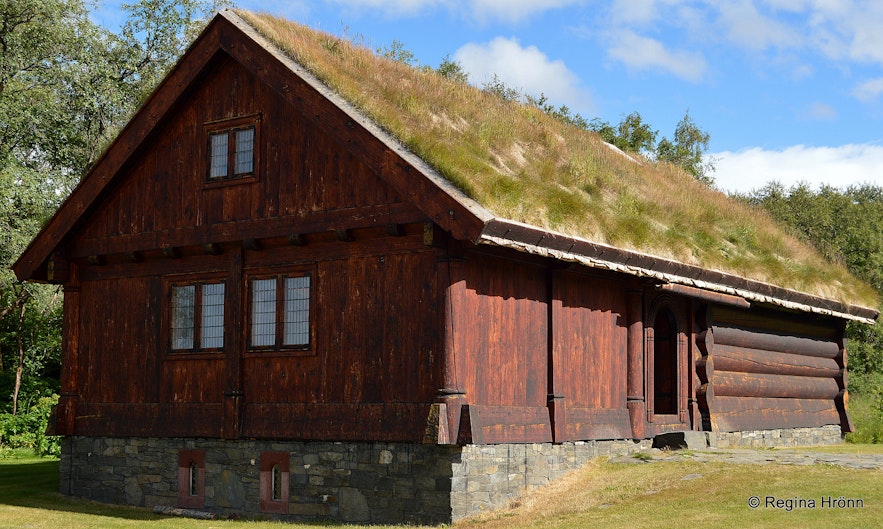
Auðunarstofa
In the early 19th century (1810) the log house was dismantled and in 2002 a new log house was built. It was erected on the Millenium of Christianisation in Iceland and finished in 2002.
The Norwegians donated the wood and it was first built in Norway, dismantled, and built again in Iceland. It is a reconstruction, built to the liking of what we think the old Auðurnastofa must have looked like.
At Auðunarstofa are the offices of the ordination bishop at Hólar located. Sólveig Lára Guðmundsdóttir, the ordained bishop (until August 2022) showed us around Auðunarstofa.
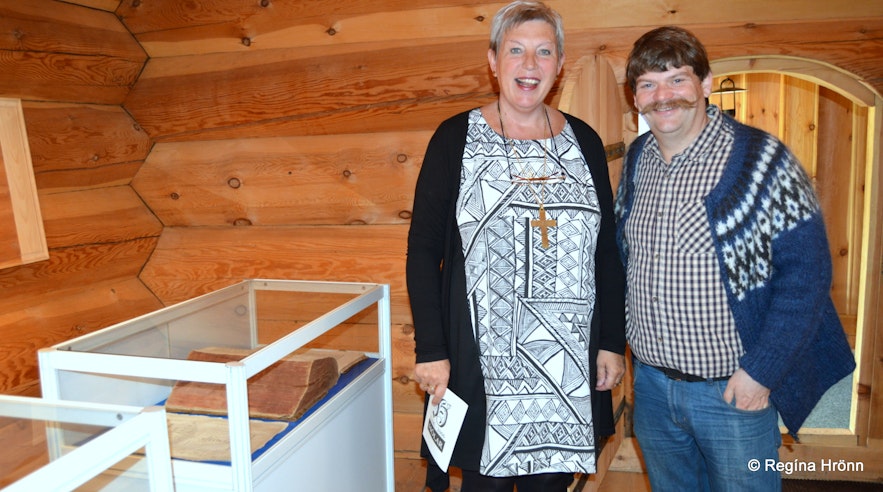
Sólveig Lára and Jón my husband at Auðunarstofa
Here is also a parlor where concerts are held and meetings and exhibitions.
In the cellar canonicals and old books are on display and the old chalices of the Cathedral at Hólar.
Gvendarbrunnur well
Gvendarbrunnur well
You will find a well called Gvendarbrunnur at Hólar. There are several wells and water sources in other places in Iceland with the same name, f.ex. at Klúka in Bjarnarfjörður.
They are said to have healing powers as Guðmundur góði Arason blessed them.
The well here at Hólar was reconstructed in the 1950s.

By Gvendarbrunnur - Auðunarstofa in the background
Guðmundur the Good was a bishop at Hólar in 1203-1237 and a saintly man. The name Gvendarbrunnur comes from the nickname of Guðmundur being Gvendur.
The main water reserve for Reykjavik in Heiðmörk is also called Gvendarbrunnar.
 The information sign at Víðines
The information sign at Víðines
Just before you reach Hólar you will notice this information sign at Víðines. It tells us about the Víðinesbattle, which took place here. Here Chieftain Kolbeinn Tumason and his 400 men attacked Bishop Guðmundur the Good and his men back in 1208 after a long dispute.
Chieftain Kolbeinn Tumason, who was married to Guðmundur's niece, died in the battle after a rock hit his head, but rock-throwing was a major part of the battles back in these days. Just before Kolbeinn died Bishop Guðmundur the good revoked the excommunication, he had put on Kolbeinn.
Mt. Gvendarskál
The view from Mt. Gvendarskál
There are lovely hikes at Hólar and a lot of things to see. One of the hikes takes you hiking up the mountain Hólabyrða to Gvendarskál, where the above-mentioned Guðmundur góði Arason, who was the bishop at Hólar in 1203-1237, used to go and pray.
On the top of the mountain, you will find an altar and a guestbook.
I hiked up to the mountain but didn't get to the altar. It is a relatively easy hike but when you reach the top it gets rocky and on the top, it is very rocky and a relatively long walk to the altar. The view from here of Hjaltadalur is breathtaking.
Mt. Gvendarskál
The population of Hólar is around 100 people but in the wintertime the population doubles in numbers.
The University specializes in horse breeding and horse-riding, fish farming, and fish biology - together with tourism. I have stayed at Hólar a couple of times through the years and have always loved my stay.
I love staying at Hólar in Hjaltadalur - this was during my stay back in 2010
To me, Hólar is such a special place that I want to stay there as long as I can.
I always stay in the same room in the cottage in the photo above.
It is a double room with access to a shared kitchen and a shared bathroom. Very lovely and quiet.
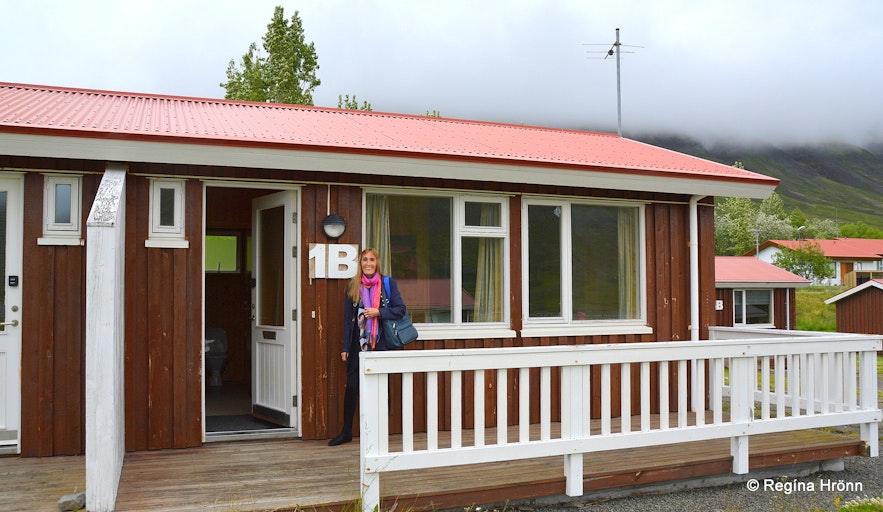 The cottage where we stayed in the summer of 2022
The cottage where we stayed in the summer of 2022
In the summer of 2022, that room wasn't available, as we booked on the day we arrived, so we stayed in a lovely cottage just above this one with a private entrance and all amenities.
 Inside our cottage
Inside our cottage
I am most definitely going to stay in this cottage again. I booked through the website of Hólar.
Ruins of an early-Christianity church in Hjaltadalur
Ruins of an early-Christianity church in Hjaltadalur
On one of my visits to Hólar in Hjaltadalur, the ordination bishop at Hólar and her husband Gylfi (who is also a minister) told me about very special ruins in Hjaltadalur. There is a new ordination bishop at Hólar since August 2022.
Ruins of a church from early Christianity in Iceland were discovered at Neðri-Ás in Hjaltadalur close to Hólar. Very few such ruins have been discovered.
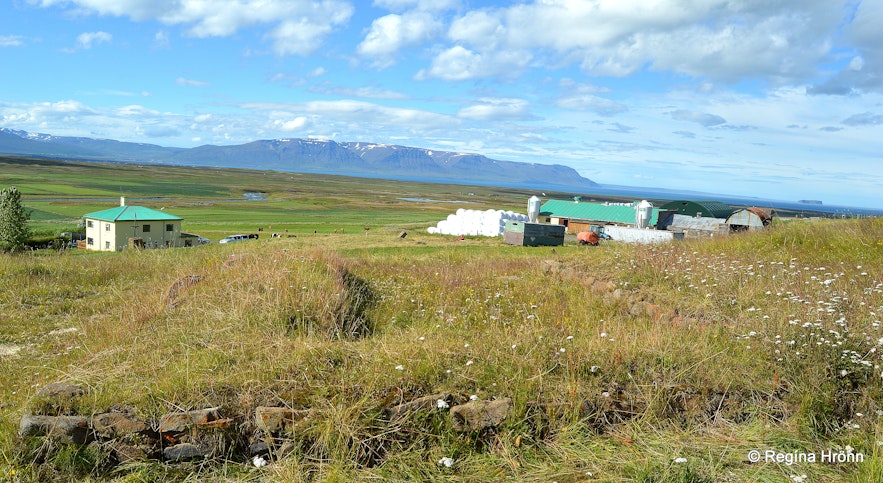
Neðri-Ás and the church ruins
The Viking Þorvarður Spak Böðvarsson lived at Ás back in the 10th century. He is believed to have adopted Christianity in the year 981 from the first missionary in Iceland - Þorvaldur víðförli.
He built a church here on his farm in 984, which was some 16 years before Christianity was adopted in Iceland. He imported wood for the church from England.
Ruins of 2 other medieval churches have been discovered here at Neðri-Ás in Hjaltadalur.
Ruins of an early-Christianity church in Hjaltadalur
The church ruins were discovered during an archaeological dig in 1998-1999. A sheep barn on this spot from the last millennium had always been referred to as bænhúsið - the house of prayer.
Beneath the sheep barn, another structure was found, and beneath that structure were the ruins of a stithy - and beneath the stithy, the ruins of this 12 m2 church were unearthed.
Some 100 graves were found by the old church - the bones seem to date back to before 1104. Hólar was founded in 1106 so people might have wanted to be buried in the graveyard at Hólar instead.
You will see a monument by the road leading to Neðri-Ás. The following is written on it: "Þorvarður Spak Böðvarsson lét gera kirkju á bæ sínum í Ási. En kirkja sú var ger sextán vetrum áður kristni var í lög tekin á Íslandi. - Kristnisaga".
Translated into English: "Þorvarður Spak Böðvarsson had a church erected on his farm at Ás. But that church was erected 16 winters before Christianity was adopted in Iceland. - the Saga of Christianity".
A heathen temple has been erected on the land of the farmers at Efri-Ás.
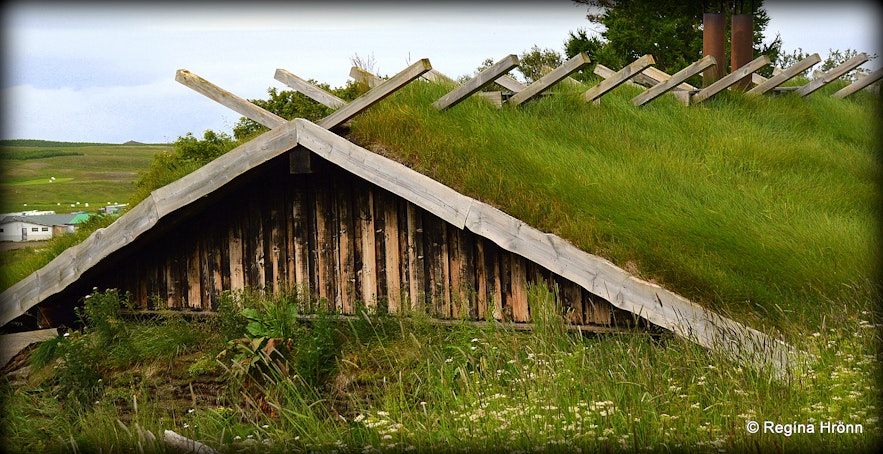 The heathen temple Ásheimur at Efri-Ás
The heathen temple Ásheimur at Efri-Ás
Extensive archaeological excavations have taken place at Hólar and you can see some of the unearthed ruins when you visit Hólar.
At the museum at Hólar, you will also see some of the artifacts found during the excavations. None of them is as old as these ruins though.
You will also see this photo below at Hólar. It is an old antependium from Hólar, which is on display at the National Museum of Iceland.
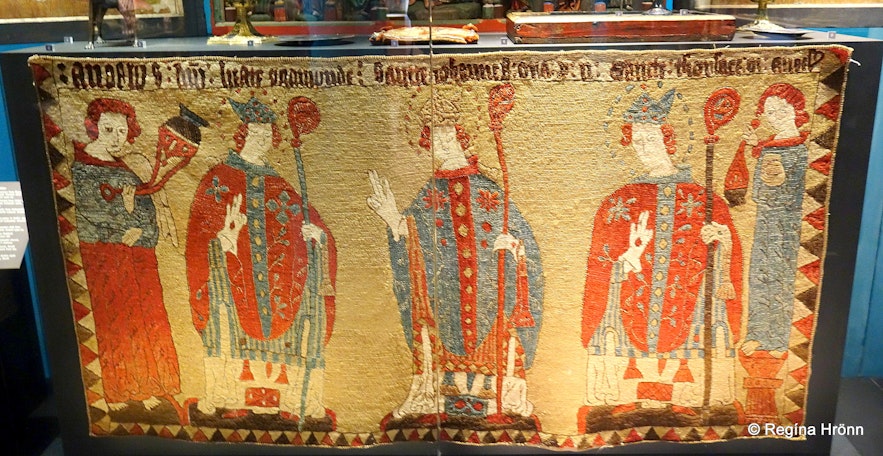 The old antependium from Hólar at the National Museum of Iceland
The old antependium from Hólar at the National Museum of Iceland
It is most likely made in Iceland around 1525-1550 and shows the 3 bishops, Guðmundur Arason the good and Jón Ögmundarson who were bishops at Hólar - and Þorlákur helgi who was a bishop at Skálholt.
These 3 bishops were revered as saints here in Iceland.
Hólar in Hjaltadalur is located some 314 km away from the capital city, Reykjavík. You can rent a car in Reykjavík and drive up to Hólar in a day or two.
Once you have reached the Viking fjord Skagafjörður drive on road 76 north and turn right on road 767. Drive for some 11 km on this road to Hólar.
Follow the sign "Velkomin heim að Hólum" or Welcome home to Hólar :)
Don't miss visiting this important historic site when travelling up north in Iceland.
Have a lovely time at the beautiful Hólar in Hjaltadalur :)
Other interesting blogs
Chasing Waterfalls in Iceland
Iceland is spectacular in so many ways and Icelandic nature is quite unique with its vast landscape, volcanic activity, geothermal areas, glacier lagoons and sceneries, black sand beaches and spectRead moreSænautasel Turf House in the Highland of Iceland
In my search for turf houses around Iceland, I visited Sænautasel, which is a rebuilt turf house on Jökuldalsheiði heath in the highland of Iceland. It is, in my opinion, an extremely cute turf hoRead moreThe Dynamic Plant Lupine
People have been asking me where to find lupines in Iceland. If you like them you should be able to find them easily in Iceland in summer. They are in bloom and visible almost wherever you drive aroRead more

Download Iceland’s biggest travel marketplace to your phone to manage your entire trip in one place
Scan this QR code with your phone camera and press the link that appears to add Iceland’s biggest travel marketplace into your pocket. Enter your phone number or email address to receive an SMS or email with the download link.


